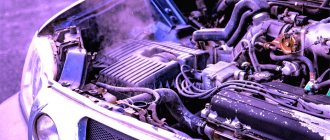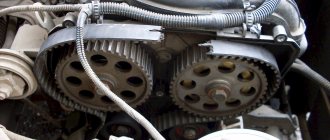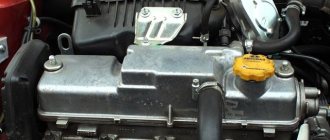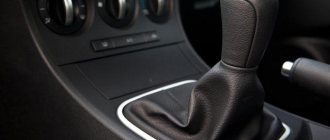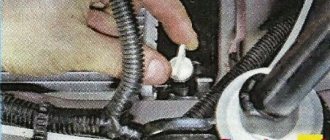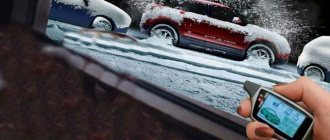Many Grants (at least approximately 2012-2015) have such a disease that sometimes (let’s say 1 out of 100 starts) the engine does not start the first time. That is, you either need to apply gas while the starter is running, or wait a few seconds and start it again. In my opinion, Putin’s test copy was also guilty of this. It looks something like this:
This occurs both cold and hot. Closer to the 70K mileage, a problem appeared that the autostart sometimes could not start the car at all (even after several attempts). As a result, I did a little maintenance, which (pah-pah-pah) seemed to solve this problem. I describe the work chronologically, it is possible that the first method already helps. T - time to work, P - price.
1. Cleaning the throttle valve. T=30 min, P=RUB 100 per spray cleaner.
The damper is unscrewed with a hexagon and pliers (if the hexagons fit tightly).
The damper position before cleaning is about 5-6, after cleaning is about 2-3:
2. Replacing the air filter. I change it about once a year, every 15,000 km. T=5 min, P=200 rubles.
3. Valve adjustment. I don’t know if there is a problem with starting the 16-cl. (write in the comments), but for the 8-cl. it is a very useful procedure. I haven’t adjusted them for about 30 thousand (or maybe more, it’s not a fact that they were adjusted at the off-site maintenance), there is an effect. I did it at a service center, the price including the gasket was about 1000 rubles.
4. Replacing spark plugs, I also change them once a year, before winter. T=15 minutes, P=200 rubles.
The cheapest spark plugs are LADA, well, they will cost 250 per set maximum.
5. Switched to TatNeft gasoline. The startup speed certainly doesn’t depend much on gasoline, but gasoline there is cheaper than Bashneft and especially Lukoil. And the car doesn’t feel like it’s losing any momentum in terms of dynamics.
That is, spending 500 - 1500 rubles may well solve the problem with launches on Grant, or at least make difficult launches less frequent.
Price tag: 1,500 ₽ Mileage: 69,000 km
FakeHeader
Comments 45
So it's not about the spark plugs or the throttle or the valves. The jamb is constructive, pumped over from previous models of vases. Since the fuel rail is located in close proximity to the exhaust tract, after trips it heats up due to the heat emanating from the cat or spider, because of this, the gasoline heats up and boils inside the ramp, therefore the pressure in the ramp drops and the car takes a long time to start hot. I personally start it this way: I turn the key to the first position several times 2-3 times, wait until the fuel pump relay clicks, and then I start it 4 times, and what do you think... It starts perfectly...
The throttle position sensor needs to be replaced.
The problem has been known for a long time and there is one more thing, replacing the coolant temperature sensor, which is located in the thermostat, changed the problem, no such problem yet. If you have a question about how a sensor can affect startup, then google it. True, the problem always arose on a warm engine, but on a cold one it always started the first time.
I got this hemorrhoid after installing Denso candles ///
I’ve had it since new and it’s not going anywhere))
What you described does not help, because... I carry out these procedures regularly, but the problem is still present.
This happens to me, but I have nothing to clean since everything is already clean and everything has been changed, but the problem remains.
one of the last ones worth
8bug ones seem to take a long time to turn, at work and at my wife’s it’s the same thing, my 16kl starts with half a kick even with a decrepit battery
Late 2015, mileage 30k, gasoline 95, fall/winter/cold spring — auto start. It never started. The rest of the time with the key, with the clutch depressed. It never started.
At 70K mileage, such garbage appeared that sometimes it could not start from autostart. And at a mileage of 20-30 it happened that the second time it started and the starter turned for a long time (regardless of the temperature)
In my opinion, these are all VAZ genes passed on from generation to generation. This happened on a tag with a mileage of 200,000+ and the same thing is observed on a grant with mileage “recently left the showroom”))
Yes, this fact exists. The solutions described are not a panacea. A design feature that does not depend on service life. But bad spark plugs and gasoline will manifest themselves in any car in one way or another, and replacing the air filter will not at all affect the starting of the car. Over almost 6 years of operation, this defect has not increased or decreased. Didn't adjust the valves 70 t.km. because the clearances were normal (dynamic driving reduces the need for valve adjustment). But literally not long ago, the adjustment of the valves (one was out of order) coincided with the next independent maintenance (replacement of oil, spark plugs, filters), as a result, the starting situation did not change. Your candles don't look very good. Mine are always dry, even after 40 thousand kilometers on one set. And the damper is not the reason, because... Since then, the problem has appeared (and even during dynamic driving this is not required, but it will manifest itself in floating speeds, deterioration in dynamics, etc.). I don’t even dare call it a problem or a defect, rather a feature of this car because... appears extremely rarely.
Starter and ignition
If the car does not start the first time or the engine starts every other time, and characteristic clicking noises are heard, then most likely the starter is to blame. In many cases, the reasons need to be looked for in the wiring and relays, and here you can’t do without the appropriate measuring instruments in order to thoroughly check and ring everything. Perhaps it's all about the wire leading from the ignition switch to the starter. If there is no voltage, you need to use a piece of wire to pass current directly from the battery and check.
In fact, the reasons why the car does not start the first time may lie in the ignition coil, in the spark plugs, or in high-voltage wires, but in such situations one cannot expect a quick solution to the problem, and most likely you will need to tinker with it yourself or drive it away. car at the service station.
Lately, problems with starting the engine have become more frequent. Moreover, it may not start once, but starts the second time. I thought it was time to change the fuel filter, so I did. Everything seemed to be fine for a day, then the engine periodically stopped starting again. I started digging around the forum, many wrote about the crankshaft position sensor, but the symptoms are not quite mine there. Sometimes the car won’t start when it’s hot, periodically stalls when driving, and if you look at the scanner there will be a DPKV error. My car did not stall while driving, and the scanner did not show any errors at all. Then I came across three main versions of the discussion on the Elantra forum elantra-club.ru/forum/showthread.php?t=29994: 1. Immo doesn’t see the key. 2. The fuel pressure regulator needs to be replaced, just in case, here is its number 31380-2H000. 3. The fuel pump needs to be replaced (existently 10,000 thousand rubles, but as I understand, the motor itself is very similar to the motor of a VAZ 2110, Bosch costs about 3,000) I started checking at home with the simplest IMMO does not see the key. I tried turning the ignition on and off several times and the Immo light actually appeared and then didn’t. When the lamp did not light up, the engine would not start.
This means you need to clean the contacts of the ignition switch block. To do this, remove the lower plastic casing of the ignition switch by unscrewing one screw from below and two screws behind the steering wheel.
Modern technologies allow manufacturers to create cars that require a minimum of attention. You get behind the wheel, turn the key in the lock - and enjoy a pleasant ride. You just turn the steering wheel, regularly replenishing the fuel supply in the tank. And suddenly - like a bolt from the blue! The car does not start the first time. What needs to be done, where to check, how to fix such a problem?
Lada Granta starts poorly when cold: reasons, video, repair
Car: Lada Granta. Asks: Firsov Maxim. The essence of the question: Is the car difficult to start when cold?
Please tell me why, when my car, a Lada Granta, sits overnight and the engine cools down, the engine does not start the first time? Although if you drive it all day, then such problems are not observed, this only happens when it’s “cold”.
The main reasons for poor cold starting.
Judging by the problem described above, there may be several reasons for the malfunction, and you need to start with the one that you think can be solved most quickly.
The following two tabs change content below.
The reasons may lie in the following:
- Poor quality gasoline - try changing gas stations.
- Pay attention to the quality of the fuel - there may be a lot of water accumulated in it.
- Check the ignition module for functionality.
- Diagnose spark plugs and high-voltage wires - spark plugs for breakdowns, and wires for cracks; if anything like this is found, then this element should be changed.
Location of spark plugs and protective caps
- Check the oxygen sensor - the mixture may not be rich at startup.
- Malfunction of injectors - it may be that one or more injectors are clogged.
- Problems with the crankshaft sensor (if this sensor is completely damaged, the car will not start).
- Low compression in cylinders.
This is a list of the main reasons why an engine may start poorly when cold.
Service or DIY repair?
Some causes can be diagnosed by yourself, but most of them will require replacement parts. Usually electricians have “guaranteed working” spark plugs, armored wires, and also if they have special ones. equipment (CO emission standards), you can check the operation of the ignition.
The procedure for returning the car to “life”
Let's say you find yourself in circumstances where the injection engine starts poorly or refuses to do so at all. There is no need to hesitate in such a situation - it is advisable to immediately begin resuscitation procedures. If you don’t have time to figure out the exact reason why the car doesn’t start well, then you should quickly carry out the following algorithm of actions:
In general, there are no particular difficulties in repairing a non-starting injector. The main thing in the process of such work is to act competently, in accordance with the procedure and possible vehicle malfunctions described above.
Lada Granta won't start in the morning when it's cold. – AutoMastera.net
Age: 2022 years old
RU
Hello dear forum users! Granta arrived with a complaint about poor starting in the morning. It starts only after being towed for about three kilometers. Then it starts with the key and continues like this all day. I connect with a scanmatic, 8 cells. ECU m 74CAN. I see errors on the channel bus: short circuit (+) to (-). Also, cylinders 1-4 are skipped and fuel supply is prohibited. I erase the errors and start it (yes, the car has a 4th generation LPG). While running on gasoline there are misfires in the 4th cylinder, on gas in the first. On gas, turn off. I understand that the 1st injector is flowing. I think that on gas it interferes with the operation of the internal combustion engine. The pressure in the ramp is 3.7. There was only one injector in stock, so I put it on the 4th. The gaps in it have stopped. But on gasoline it still works very poorly, when the speed increases, it sneezes as if there is not enough fuel. All parameters are normal. Again, I measure the pressure in the ramp during operation, at some point it drops sharply and the engine starts to shut down. I am changing the pressure valve in the tank. Left. In the morning, the same story was barely started again. What could be the reason? Yes, I opened the ecu completely, everything is clean. Comrades, more experienced diagnosticians, I ask for advice, maybe someone has had something similar. I apologize if anything, but I didn’t find anything like this on the forum. Favorites0 Bookmarks Collections0 Raise topic0 Lower0Reply Thank you!1Age: 2022 years old
- I was told 1 time
- I said 4 times
RU
Edited by: Grinius on 10-6-2018 20:58 The valves say they were adjusted a week ago, they thought it was because of them. Last night it was with me. On the first start in the morning it started and stalled. The second launch is generally zero. Errors 0, I reset the training, it starts, I don’t press the gas too confidently and it stalls. I start it up again, it idles and thrashes, I switched to gas and then I revved it up. Rail pressure 3.6 Well, I see there are no thoughts yet. He'll come again tomorrow. For now I think it’s the injector that is pouring and the gasoline gets to the lambda and the car stalls. Well, I don’t know anymore. Answer Like Dislike Thank you!1Age: 37 years old
- I've been told 194 times
- I said 95 times
RU
The ECU was reset. Suction? Gas hoses from gas injectors to the manifold used to crack. The quality of the fuel, which may have been hanging around in the tank for a month and simply won’t burn anymore? Is the canister purge valve not leaking? How do you correct the fuel supply after resetting the ECU when running on gasoline? Answer Like Dislike Thank you!194- I've been told 36 times
- I said 22 times
RU
This happened a couple of times, it was due to the very low quality of gasoline, the first run was done with Winx flushing fluid. Answer Like Dislike Thank you! 36Age: 48 years old
- I was told 2 times
- I said 3 times
RU
8# Published 10-6-2018 21:10:11 | Author's messages | Google Chrome 66.0.3359.170| Windows 10Crankshaft and coolant sensors
Sometimes the car does not start even if the starter, fuel pump are working properly, or the control unit, spark plugs, and battery are in order. Why is this happening? To understand, check the crankshaft sensor. It is quite possible that it is on the verge of wear. The sensor is connected to a multimeter, and a screwdriver is moved along its end.
Voltage surges should be reflected on the device. There should be a resistance of 750 ohms between the contacts. If there is a discrepancy, the crankshaft sensor must be replaced.
A faulty coolant temperature sensor gives false readings, causing the on-board electronics to block startup. It must be replaced.
Lada Granta Lucky › Logbook › In the morning Granta starts the second time. Solution
With the arrival of lower temperatures in the fall, +2 during the day and at night below -1, I noticed such a strange feature that in the morning when starting the car it starts without problems, but it runs for 2-4 seconds and immediately turns off as if I had specially turned it off with the key. And this is only in the morning, throughout the whole day everything works as soon as it came from the factory.
I looked at similar problems on the Internet, the solution is different everywhere and not for Grant, supposedly the idle speed sensor is covered and the like. I’ll say right away that I was also thinking about it, but after looking at the technical instructions for the module I realized that there are no floating speeds and it’s almost impossible to refuse, except for the fact that “carbon deposits” form on the air damper and you have to pay 4,000 rubles for the module because it’s a sensor located in it and not sold separately, I didn’t see the point. As a result, I came across a post www.drive2.ru/l/3061895/ where a fellow sufferer, also with a similar problem, had already tried to solve it. I decided to change the battery because it was winter and the factory one was already 3.5 years old. Allegedly, on old Viburnums, due to a weak battery, the on-board power goes out in the morning when starting up, and the ECU, seeing this, forcibly turned off the engine. As a result, I bought a Topla 60Am/h battery with a starting current of 510 for a price of 3800. And I started waiting for the next morning to check if it would help or not. As a result, the new battery has the same problem.
I came across another post www.drive2.ru/l/8154330/ where the same fellow sufferer had already changed the fuel pressure valve, which is located in the fuel pump module, did not wait long and went for a new valve, 500 rubles for the valve itself and the rubber seal between the module and a body, which was not useful at all, but it costs 100 rubles. As a result, I started replacing it, I’ll say right away that if you take out the fuel pump, be careful with the fuel level sensor (the float hanging on the L-shaped wire) because when I removed it, I did something to it, which is why it stuck and showed an empty tank. I had to take it out several times to fill everything under the seat with gasoline in order to return the stuck part to the dangling mode)) (I just moved my fingers, twisted it so that it began to move more or less freely and lowered it back into the tank) Another nuance when removing it, I did not see how the O-ring was standing, so initially I simply installed it on top, after which I could not understand why the retaining ring did not want to fit into the grooves. DO NOT REPEAT my mistake otherwise you will swear. Correctly it should be put on the gas tank opening itself.
The O-ring is positioned correctly. For pioneers like me
And one more nuance, wipe everything very well from dirt and especially under the sealing ring, there are such sockets there. As a result, while I was struggling with the float, this is what I noticed: when I had the old valve installed, when I removed the tubes from the module for the first time, it didn’t even spray due to the lack of pressure, and when I had already replaced it with a new one, I started removing it a second time , squeaked so hard it hit the back of the seat. Already at that moment it became clear that the old thing had come to an end. Now I’ll wait for the next morning to finally be happy, or maybe upset again)))) I didn’t take any photos because there is a lot of information on removing the fuel module and replacing the valve on the Internet or in a book who has it. By the way, there was a lot of dirt in the tank. It needs to be washed in the summer. It took a little over an hour, everything was simple and easy) The tool included a hammer (for knocking out the retaining ring), 2 types of screwdrivers and that’s it) and a lot of rags for wiping off dirt and gasoline.
Gasoline pump
In winter, fuel pump interruptions increase. It is clear why this happens - due to low temperatures. The starter turns the flywheel, but you can’t hear the fuel pump running, and the “exclamation mark” flashes on the instrument panel. It is necessary to immediately measure the pressure in the fuel supply system. Under the hood, on the ramp with the injectors, there is a cap with a nipple attached to it. By clicking on it, we will see how fuel splashes out. If this happens, the fuel pump is working.
The relay may also break. Inside the transmission tunnel on the passenger side there is a casing where the power coils are located. They need to be warmed up or tapped. The serviceability of the fuel pump is determined by checking the voltage. The multimeter reading should be around 12 V. If this is not the case, check the fuses and relays.
Granta won't start - spark plugs are dry
After the spark plugs have been removed, we inspect them. Dry spark plugs indicate that gasoline is simply not supplied to the cylinders. There are a huge number of reasons for this, but the main ones are quite typical. First of all, turn on the ignition, and then listen to see if the fuel pump is working. If it does not work, then we listen to see if the fuel pump relay clicks after turning on the ignition. If it does not click, it means there is no voltage supplied to it, and this in turn means that either the fuse has blown or the problem is in the ignition switch. We almost completely exclude the second option, because this is a special case that requires separate consideration.
After we have made sure that voltage is supplied from the ignition switch to the fuse, and then from the fuse to the fuel pump relay, we lift the back seat, and then remove the chip from the fuel pump. Here we need either a multimeter or a test lamp. Turn on the ignition, the lamp should light up, or the multimeter should show a voltage of 12 volts at the terminals of the block. If there is none, then we look for a break along the path from the fuel pump turn-on relay to the fuel pump itself. It is worth clarifying that this is a very rare case, which in practice is almost impossible; you should start the search from the chip itself; most likely, the wire broke at its base.
After we are convinced that the fuel pump is pumping fuel, we go into the engine compartment, find the fuel rail, unscrew the cap from it, and then press the spool. Naturally, this must be done with the ignition on. What is all this for? This is necessary in order to clarify whether the fuel rail is pressurized. The pressure in the fuel rail may not build up at all; the reason for this is most likely either the fuel filter, which is clogged, or the fuel pressure regulator in the fuel rail. Checking the filter is quite simple. To do this, you need to disconnect the fuel supply from the fuel rail and then turn on the ignition. You need to put some old one under the hose; a working fuel system will fill a liter bottle pretty quickly. In order to check the fuel pressure regulator, you need to pinch the hose that goes from the ramp to the fuel tank. This is the so-called return. We pinch it, and then press the spool. With a clean fuel system and a working pressure regulator, fuel will definitely flow from the spool. After we have made sure that the fuel is reaching the ramp, we need to find out whether the injectors are opening. This is a very difficult task without a specific tool. Therefore, we simply turn the starter, after which we unscrew the spark plugs, and then look at their condition. Naturally, if the spark plugs remain dry even after this, it is obvious that the injectors are not opening. All injectors cannot fail at once, so it is logical to assume that for some reason the control unit does not send impulses to them. One of the reasons for this behavior may be the operation of the immobilizer, which blocks the operation of the injectors because it does not recognize the key. In this case, the buzzer will notify the driver with a double signal. If this does not happen, then take a multimeter in your hands, turn on the ignition, and then measure the voltage between the red-pink wire that goes to the injectors, as well as the ground of the car. The fact is that the injectors in this case are controlled by minus, that is, plus is constantly supplied to them. The minus is supplied in pulses under the control unit. If positive comes to the injectors, then it is logical to assume that the control unit does not understand the position of the crankshaft. Naturally, we look at the crankshaft sensor chip.
Control block
The problems described above are easy to diagnose. But in the case of ECU failure, the situation is more complicated. Usually, if no one has touched the ECU, it works without any complaints. But more often there are situations when the block is filled with antifreeze due to its location.
If not and there are suspicions of ECU errors, you can try removing the negative terminal of the battery for a while. As a result, all sorts of errors will be reset. Often, it is impossible to start the engine due to CAN errors.
Lada Granta does not start - spark plugs are in gasoline
If the unscrewed ones are wet, then it is logical to assume that gasoline is entering the cylinders. Accordingly, you need to dig towards the spark. Everything is definitely fine with the DPKV, because the ECU sees the scrolling and opens the injectors.
On a car with an 8-valve engine, where an ignition module is installed, this procedure is much simpler than on cars with a 16-valve engine. First, we need to make sure that voltage is supplied to the ignition module, namely, to the primary winding of the module. To do this, remove the chip from the module, and then turn on the ignition. There should be 12 volts between the center wire and ground. If they are not there, then check all the wiring to the control unit. If everything is fine with it, then with 90% confidence we can say that the problem is in the ECU. After we went to the cartoon, power is supplied, we check the module itself. To do this, use the same multimeter to check the resistance of the primary winding. It is measured between the second and third terminals of the coil.
The resistance should be about 1.2 kOhm. After this, we check the resistance of the secondary winding coils. To do this, it is measured between the terminals on high-voltage wires 1 and 4, as well as cylinders 2 and 3. This resistance may differ among different manufacturers, so here it is looked at relative to each other. On average, the indicator varies from 6.5 to 12. It is worth clarifying that this method of checking the module may not always be reliable, since the coil has different characteristics at different thermal conditions. It remains to check the high-voltage wires; we measure their resistance with a multimeter; it should be no more than 5 kOhm on the shortest wire, and no more than 10 kOhm on the longest wire, respectively. Unfortunately, checking high-voltage wires for breakdown at home is quite problematic; this may require at least a megaohmmeter. Many people, in the absence of a spark and wet spark plugs, immediately jump to check the crankshaft position sensor. Here it must be said that the fuel supply to the cylinder already indicates that this sensor is working. But how reliably it shows the position of the crankshaft is difficult to say. At home, it is easier to check the crankshaft position sensor by replacing it with a known good one.
This is a list of typical faults that cause Lada Granta to not start. It is worth noting that the actual list is much larger than this, since every case cannot be typical. It also happens that, for example, the injectors behave adequately when cold, but after warming up they begin to spray. But it happens the other way around: when it’s cold, they cannot provide sufficient performance, but when it’s hot, on the contrary, they work properly. Unfortunately, even in big cities it is often quite difficult to find a competent specialist in engine diagnostics. This line of work requires at least three elements to work. The first is a motor tester. They are quite extensive, so there is no point in considering them. The second is a diagnostic scanner. It is often very difficult to find a multi-brand scanner with good functions; in addition, its cost exceeds all reasonable limits. The third is a gas analyzer. Equipment for engine diagnostics alone costs at least 200 thousand. In addition, training takes quite a long time. Therefore, very few people are involved in diagnostics, if we talk about competent diagnostics. Well, one more case why the Lada Granta may not start. Video - Lada Granta does not start:
Immobilizer
If the car suddenly refuses to start, it is most likely that the main problem lies in this electronic unit. Every car enthusiast can see immobilizer malfunctions on his own if he wishes. On the dashboard - instrument panel - the icon corresponding to this breakdown begins to blink. At the same time, you can hear a characteristic beeping sound.
In this case, the manufacturer recommends that you immediately carefully read the operating instructions. The problem is not so easy to fix. In the decoding attached to the car, the manufacturer indicates the alternation of flashes and sounds.
The car owner must calculate:
- number of seconds between LED flickers;
- number of alarm sounds;
- read what the instructions recommend.
Severe frosts lead to the fact that the engine sometimes starts only the sixth time. This is a normal phenomenon, since the fuel partially changes its ignition properties, the injectors operate in unusual modes. The situation immediately changes if you retrain the ignition key. After such an operation, the problem with starting the engine in the cold disappears.
